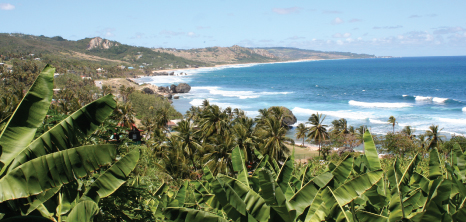|
CrabsGenerally covered with a thick exoskeleton, crabs carry a single pair of claws, four pairs of legs and typically walk sideways. They are omnivores and feed primarily on algae. However, many of them prefer to have a combined diet from the plant and animal kingdom so as to aid in rapid growth and fitness.
Their method of communication is by drumming or waving their claws. Males tend to be aggressive and fight each other when trying to win over a female. They also have a reputation for fighting each other over hiding holes.
During mating season, crabs work in collaboration with each other to provide food and protection for their families. Also of primary importance, is their duty to find a comfortable place for the females to lay their eggs.
Types of CrabsIn Barbados there are a few crabs common to our shores. They include the ghost crab (Ocypode quadrata), the large, red, sea crab (Carpilius corallinus), the scuttle (Grapsus grapsus), the shugguh (Callinectes), the small red crab (Gercarcinus spp.), the soldier crab and the swampee (Cardisoma guanhumi).
Ghost CrabsThis translucent looking land crab scuttles along the waters’ edge mainly at night in search of food with the greatest ability to disappear from sight almost instantly. Despite the fact that they can survive for up to 48 hours without contacting water, they must return to moisten their gill chambers and lay eggs.
It is locally known as a "belly or Betty conscience and is used for fish bait. Their excellent 360º vision is aided by their two black eyes.
Large, Red Sea CrabsConsidered to be one of the most beautiful crabs in Barbados, this brick red coloured sea crab lives in coral reefs and rocky rubble in shallow waters. Seen as a delicacy, this crab has a hard upper shell that is smooth, heavy and covered with scarlet spots and small white or yellow winding lines.
Scuttle CrabsThis brown, speckled crab can be commonly found on the waters’ edge and feeds primarily on algae. It is perfectly camouflaged for its environment which is amongst rocks that are slightly out of reach of seaspray. This quick moving crab is not considered edible by human-beings but used as bait by fishermen.
Shugguh CrabsWell known for the nasty bite it can give to swimmers in shallow waters, the Shugguh crab is a swimming crab with a rough, shaggy shell. Crabs in this family are characteristically olive-green or blue on the back with blue or red areas covering their relatively small claws. They can vary in claw size and colour.
|



